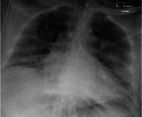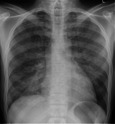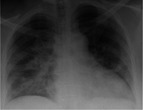To the Editor,
We would like to report the clinical characteristics of three people living with HIV (PLWH) in the United Kingdom within the context of coronavirus disease‐2019 (COVID‐19). Our institution serves a population of 500 000 with a prevalence of HIV at 0.34%. At of the time of writing, 5th June 2020, only three PLWH tested positive for severe acute respiratory syndrome coronavirus 2 (SARS‐CoV‐2) on nasopharyngeal swab specimen using real‐time reverse transcriptase‐polymerase chain reaction have required admission to hospital. These account for 0.43% of total COVID‐19 admissions to our hospital where the overall mortality rate is currently 27%. There are scarce data available on PLWH and COVID‐19 and although our case series is small, it may be relevant.
We treated three Black patients: two male and one female. One male patient required intubation soon after admission and died in the intensive care unit (ITU) while the other two patients required continuous positive airway pressure and were subsequently discharged in a good condition. Preadmission CD4 counts varied from 50/mm3 to 890/mm3 and each patient was prescribed different antiretroviral therapy (ART) regimens, none of which contained lopinavir‐ritonavir. Two of the regimens contained tenofovir which has theoretical antiviral activity. 1 , 2 They all remained on preadmission ART regimens in accordance with guidance from the British HIV Association. 3
Patient 1 was a 62‐year‐old polymorbid Nigerian male with risk factors for poor outcomes in COVID‐19. He had received a renal transplant, was immunocompromised from tacrolimus and mycophenolate treatment, and also had type 2 diabetes (T2DM) and hypertension. He was intubated and ventilated on ITU and died from multiorgan failure precipitated by COVID‐19 pneumonitis. A high mortality rate has been associated with transplant patients infected with COVID‐19 who require hospitalization 4 and this, alongside other comorbidities, all of which are cited as poor prognostic markers, likely contributed to death rather than HIV status. Patient 2, a 46‐year‐old Jamaican male with glucose‐6‐phosphate dehydrogenase (G6PD) deficiency, had been ART naïve until 5 days before admission after he had been lost to follow‐up since diagnosis in 2013. With a CD4 count of 50/mm3 and a viral load more than 1 million/mL, in the setting of COVID‐19 infection, it was felt likely he had added Pneumocystis carinii pneumonia and this was later supported by positive serum beta‐d‐glucan. He was treated with atovaquone in view of G6PD deficiency and had a good outcome. Patient 3, a 57‐year‐old Zimbabwean female with a history of stroke, T2DM, hypertension, and obesity, was a nurse in an older persons care home with confirmed COVID‐19 infections at the time of admission. She also was covered for added bacterial infection and was discharged in a good condition (Table 1).
Table 1.
Demographics, clinical characteristics, treatment, and outcomes of three patients with HIV and COVID‐19 are demonstrated
| Patient 1 | Patient 2 | Patient 3 | |
|---|---|---|---|
| Demographics | |||
| Age, y | 62 | 46 | 57 |
| Sex | Male | Male | Female |
| Ethnicity | Nigerian | Jamaican | Zimbabwean |
| Comorbidities | Renal transplant 2012 | Smoker | Hypertension |
| T2DM on insulin | G6PD deficiency | T2DM | |
| Hypertension | Obesity | ||
| Latent tuberculosis | Stroke 2007 | ||
| Graves disease‐in remission | |||
| Reflux | |||
| HIV status | |||
| Year of HIV diagnosis | 2002 | 2013 | 2012 |
| CD4 cell count at or before admission (cells per µL) | 180 | 50 | 890 |
| CD4:CD8 ratio at or before admission | 1.9 | 0.2 | 0.6 |
| HIV viral load at or before admission (copies per mL) | Not detected | >1 million | Not detected |
| ART regimen on admission | Raltegravir 400 mg BD Lamivudine 50 mg OD Abacavir 600 mg OD | Truvada 200/245 OD Dolutegravir 50 mg OD | Descovy 200 mg/25 mg Nevirapine 400 mg OD |
| Clinical findings on admission | |||
| Duration of symptom, d | 4 | 19 | 10 |
| Chest X‐ray on admission |

|

|

|
| Symptoms and initial observations | |||
| Symptoms | Dyspnea and a dry cough | Productive cough and fevers | Dyspnea, a dry cough, fevers, anorexia and headaches |
| Respiratory rate (breaths per min) | 40 | 18 | 34 |
| O2 saturation in room air | 85% | 95% | 92% |
| Temperature, °C | 37.5 | 37.5 | 38.6 |
| Blood pressure, mm Hg | 164/83 | 103/72 | 123/71 |
| Heart rate (beats per min) | 132 | 98 | 85 |
| Initial laboratory results | |||
| White cell count (cells per 106/L) | 11.93 | 8.59 | 4.31 |
| Lymphocyte (cells per 106/L) | 0.23 | 1.13 | 1.1 |
| Platelets (cells per 106/L) | 145 | 293 | 208 |
| LDH, U/L | 532 | 440 | 454 |
| CRP, mg/dL | 260 | 51 | 78 |
| D Dimer, ng/mL | 7163 | 1766 | 546 |
| Troponin, ng/mL | 62 | 6 | 8 |
| Ferritin, ng/mL | 717 | 2913 | 1925 |
| Treatment and outcomes | |||
| ART | Not altered | Not altered | Not altered |
| Other antibiotics | Tazocin | Levofloxacin | Doxycyline |
| Azithromycin | Atovaquone | Co‐trimoxazole | |
| Co‐trimoxazole | |||
| Admitted to ITU | Yes | No | No |
| Invasive or noninvasive ventilation | Intubated and ventilated | CPAP | CPAP |
| Corticosteroids | On prednisolone at admission | Prednisolone | No |
| Length of admission (nights) | 8 | 6 | 10 |
| Outcomes | RIP | Discharged | Discharged |
| Additional comments | Tacrolimus and mycophenolate held on admission to ITU, prednisolone continued | ||
Abbreviations: ART, antiretroviral therapy; COVID‐2019, coronavirus disease‐2019; CPAP, continuous positive airway pressure; CRP, C‐reactive protein; ITU, intensive care unit; LDH, lactate dehydrogenase; RIP, rest in peace; T2DM, type 2 diabetes.
We suggest that HIV alone does not result in amplified risk of infection or adverse outcomes in COVID‐19 infection when compared with the general population. This is supported by case series from both Germany and America, where no excess morbidity or mortality was found among patients with HIV. 5 , 6 Furthermore, Karmen‐Tuohy et al 7 compared a cohort of HIV‐positive patients to a matched non‐HIV cohort and concluded that HIV coinfection did not significantly impact presentation, hospital course or long‐term outcomes. Patient 2 of our series, who in retrospect fulfilled AIDS defining criteria, did not suffer a more severe disease course—the assumption being that even these patients are not necessarily at heightened risk. As HIV is seen in an increasingly aging population, these patients may have comorbidities which independently augment the risk of adverse outcomes, and therefore, any conclusions drawn should be cautious. We postulate that patients with HIV may even be somewhat protected if established on ART. 8 All of the above hypotheses need to be validated by further research with greater patient numbers.
CONFLICT OF INTERESTS
The authors declare that there are no conflict of interests.
ACKNOWLEDGMENT
The authors received no specific funding for this study.
REFERENCES
- 1. Wu Q, Chen T, Zhang H. Recovery from COVID‐19 in two patients with coexisted HIV infection [published online ahead of print May 13, 2020]. J Med Virol. 2020. 10.1002/jmv.26006 [DOI] [PMC free article] [PubMed] [Google Scholar]
- 2. Jockusch S, Tao C, Li X, et al. Triphosphates of the two components in DESCOVY and TRUVADA are inhibitors of the SARS‐CoV‐2 polymerase. bioRxiv. 2020;22:826‐828. [Google Scholar]
- 3.British HIV. Association. BHIVA guidance for the management of adults with HIV on antiretroviral treatment (ART) during the coronavirus pandemic. 2020; https://www.bhiva.org/file/5eac2b1e84f0f/BHIVA-interim-ART-guidelines-COVID-19-01052020.pdf. Accessed May 31, 2020.
- 4. Zachariah U, Nair SC, Goel A, et al. COVID‐19 in kidney transplant recipients. Am J Transplant. 2020;192:2. 10.1111/AJT.15967 [DOI] [Google Scholar]
- 5. Härter G, Spinner CD, Roider J, et al. COVID ‐19 in people living with human immunodeficiency virus: a case series of 33 patients. Infection. 2020;70(4):643‐652. 10.1007/s15010-020-01438-z [DOI] [PMC free article] [PubMed] [Google Scholar]
- 6. Ridgway JP, Farley B, Benoit JL, et al. A case series of five people living with HIV hospitalized with COVID‐19 in Chicago, Illinois [published online ahead of print May 29, 2020]. AIDS Patient Care STDS. 2020. 10.1089/apc.2020.0103 [DOI] [PMC free article] [PubMed] [Google Scholar]
- 7. Karmen‐Tuohy S, Carlucci PM, Zacharioudakis IM, et al. Outcomes among HIV‐positive patients hospitalized with COVID‐19 [published online ahead of print June 01, 2020]. medRxiv. 2020. https://www.medrxiv.org/content/10.1101/2020.05.07.20094797v1 [DOI] [PMC free article] [PubMed] [Google Scholar]
- 8. Joob B, Wiwanitkit V. SARS‐CoV‐2 and HIV [published online ahead of print March 27, 2020]. J Med Virol. 2020. 10.1002/jmv.25782 [DOI] [PMC free article] [PubMed] [Google Scholar]


